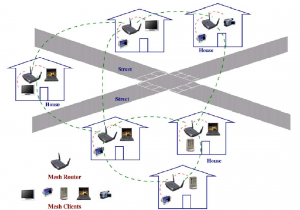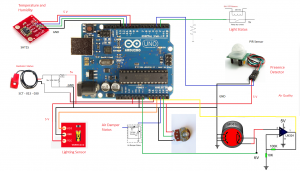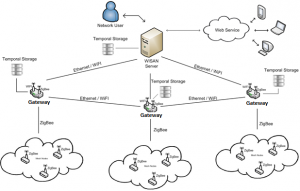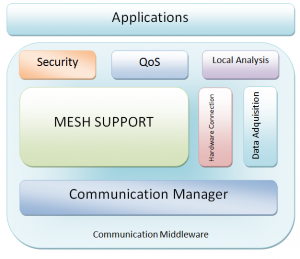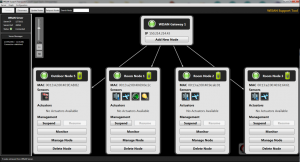Comunicación Greencities&Sostenibilidad 2013/Comunicaciones Científicas/Edificaciones
Abstract
Wireless Intelligent Sensor and Actuator Networks (WISAN) are gaining market acceptance in Building Automation Systems (BAS) because they are both cheaper and faster to deploy than traditional wired field-buses. However, a number of issues are raised when adapting this technology to the concrete domain of BAS. Aspects such as reliability, timing constrains and security are of paramount importance in this systems. On the other hand, other features related to energy consumption and self-configuration are not as relevant as in other WISAN applications, as the topology is determined by the building and the location of the energy and HVAC components and power supply is available in most of the cases.
This paper presents the design of the hardware and software of the WISAN platform specifically developed for Building Automation in the context of the SEEDS project. The platform includes modular configurable hardware, a reliable communication infrastructure and software tools for helping the maintenance and deployment of the monitoring and actuation system
1. Introducción
SEEDS-SENS has been developed in the contex of the SEEDS (Self Learning Energy Efficient builDings and open Spaces) project. SEEDS aims to develop a novel system for real-time monitoring and control of energy consumption parameters inside buildings and surroundings or districts based on self-learning and optimization techniques. One of the key components in SEEDS is the monitoring infrastructure. The development of self-learning control algorithms requires a large number of real-time data, obtained during the normal operation of the building and covering different seasons over at least one year. Such monitoring infrastructure is not usually available in most of the buildings and installing a traditional wired monitoring system for a large number of sensing points will incur in very high costs.
SEEDS-SENS is a WISAN platform that tries to fulfill the monitoring requirements of the SEEDS project. These requirements have been defined after a careful analysis of the monitoring needs and the equipment to be controlled.
The SEED-SENS hardware platform is a low cost platform, based on the Arduino Open Architecture. It has been designed to include their own sensors when needed (temperature, humidity, air quality, presence, energy consumption) or to use the sensors previously existing in the building.
The communication middleware implements an efficient fault-tolerant routing algorithm, which ensures that in the event of communication errors (due to power-loss, environmental obstructions, etc.) critical data can still reach its destination. It is based on the mesh configuration of IEEE 802.15.4 and has been designed to fulfill the SEEDS security, reliability and real-time requirements.
In addition to the hardware platform and the communication middleware, SEED-SENS includes two software tools for network maintenance and for network deployment and configuration. The network maintenance application allows the user to:
- Know the state of the nodes of WISAN
- Monitor data from WISAN in real-time
- Change the state of the actuators
- Change the configuration of the nodes
- Add/Remove/Suspend/Resume nodes
The network deployment tool is based on the IFC building standard. The tool allows loading and visualizing an IFC building model, where the user can position sensors and actuators. The tool performs a network coverage analysis, providing the number and position of network routers needed in order to achieve full connectivity among the nodes.
The rest of this paper is organized as follows. Section 2 review the state of the art and technology in wireless communications for BAS. Section 3 describes the main features of the hardware platform. In Section 4, we present the high level architecture of the middleware and the main characteristic of the network design and maintenance tools. We finalize with a section with conclusions and future work.
2. Wireless Technologies in Building Automation
The most significant communication standard in the field of WISANs is IEEE 802.15.4 (commonly known as Zigbee). Its specification was approved in December 2004 and the first profile related to BAS (Home automation) was presented in November 2007. This standard is grounded in three application domains: residential and commercial buildings together with industrial settings. The main actors in the field of BAS (Johson Controls, Siemens, TAC, Honeywell and Trane) have introduced several products based on ZigBee during the last few years and forecasts say that about 20% of building control automation systems will be wireless in the near future.
The open WirelessHART standard appeared in 2007, and it is considered (De Biasi, et al., 2008) as an open wireless standard suitable for process measurement and control applications. WirelessHART networks are composed of several elements such as field devices, gateways and network and security managers. The field devices can be organized in a mesh topology and the gateway is the bridge between the field devices and the host application. The network manager is responsible for configuring the gateway and the remaining devices using HART commands to communicate. In addition, the network manager is also responsible for maintaining the whole network including routing tables or network monitoring. The security manager tries to prevent intrusion and attacks against the network using session keys, joint keys and network keys. Bandwidth optimization and Qos are considered in this standard including several mechanisms. Reliability is also considered but it introduces additional network overhead and a trade-off between reliability and overhead has to be found.
The ISA 100.11 a-1009 standard (ISA, et al., 2009), part of the International Society of Automation (ISA) was approved in September 2009. It focuses on devices with low delay requirements (up to 100 ms), but new releases on factory and building automation applications are expected. ISA 100.11a networks are composed by field devices, gateways and handheld devices. The field devices can provide routing functionalities and the gateway ensures the connection between the network and the user application, supporting interoperability with other standards such as WirelessHART. This standard considers QoS, security and includes mechanisms to optimize the bandwidth utilization.
With respect to BAS and wireless communications, the first open communication protocols in this field appeared in the 90s, where BACNet and LonTalk had the higher impact, especially in USA. These protocols have evolved allowing IP communications (e.g. BACNet/IP). The integration of these protocols in wireless environments is a significant advance that allows interoperability with current systems. In this sense, the integration of Zigbee and BACNet is being researched in a common project of ASHRAE (American Society of Heating, Refrigerating and Air-conditioning Engineers) and the ZigBee Alliance.
The main problem in these networks is related to network reliability and quality of service control. Reliability is influenced by the low power of these devices and frequent failures in the nodes which motivate constant changes, increasing network traffic. This problem is even worse because of the possibility of interferences with other wireless networks such as those based on 802.11b, which share the same frequency (2.4 GHz).
An option to increase reliability is to use fault tolerance mechanisms (redundant routing), but they have a high cost in terms of messages, so they could effect the quality of service aspects (in addition to the economic cost). A possible solution explored in this project is to use knowledge of the domain to identify the kind of error. In this way, it is possible to avoid generic algorithms which consider non typical scenarios in this domain.
In the case of Building Automation Systems (BAS) there are systems with very different reliability requirements. So, for example, the requirements in a fire detection system are very different to the requirements in lighting or temperature control systems. In the case of quality of service in real-time systems, the problem is the same. The controllers used in BAS do not have high bandwidth requirements. They usually need ranges from several tens to hundreds of Kbps, but the incorporation of new services such as voice/video transmission in video-vigilance system or multimedia services (more and more frequent) increases the bandwidth requirements.
Coverage problems are also a typical problem inside buildings. In contrast to outside deployments where the main factor to consider in the signal level is the distance, to predict the propagation of signals inside buildings is more complex and it even depends on dynamic factors (Waharte, et al., 2006). In the case of BAS, the effective use of wireless sensors depends on tools which allow the analysis of the coverage by considering the building features and help to design a suitable wireless infrastructure in order to maintain the signal. In this project, Wireless Mesh Networks (WMN) will be used. This technology has some advantages with respect to other common wireless network technologies such as Zigbee: The WMN infrastructure provides most of the ad-hoc communication advantages of sensor networks and, at the same time, they help to structure, in a better way, networks where the deployment of the nodes is a-priori known as in the case of BAS.
The efficiency in the energy consumption of nodes in a sensor network has been a major research topic since the origins of this technology. Sensors and actuators have to be very efficient in using energy because their power is provided by batteries. In the case of BAS, this is a significant issue, because the maintenance costs could be too expensive if the batteries do not last long.
In addition to these problems, which are partially shared with other application fields where sensor networks are used, there are other problems that have to be especially considered in this context (but not only in this context):
- Interoperability: One of the main problems in current BAS is the lack of interoperability between subsystems. Often, it is possible to find controllers which are able to register only a specific data type and therefore they are not compatible with other control systems. This fact limits the capacity of the control system. The objective is to develop a system able to integrate different sensor and control systems. This way high comfort and energy-efficiency levels can be obtained. In the case of wireless systems, this problem has an easier solution because the data share the communication infrastructure and therefore the interoperability will depend on considering this factor when designing the infrastructure and the controllers.
- Configuration and control software: The deployment of a BAS requires an important effort related to configuration and software development. Over the last few years, control companies have developed configuration tools which help to reduce these costs. These tools provide graphical user interfaces which allow the use of standard control and monitoring components for different equipment. However, the process is still very difficult and error-prone. Additionally, changes in the building can require the partial change of the software of the system. In the case of wireless networks, the design of the control systems (SCADA) and the configuration tools will allow a higher flexibility because the reconfiguration and adaptability capacities of both, nodes and communication infrastructure are better than available in current systems.
- Interaction with grids: The management of energy consumption in BAS systems can benefit from the real-time monitoring of the system. Gas, electricity, and water suppliers are improving their monitoring networks in order to improve the management of their resources. In the same way, it is a typical practice to change the rates depending on the time and consumption level of the users. Nowadays, the access to this information is limited, but in a short while the users could know this information. There are several European initiatives in order to fix standards for the equipment for controlling equipment using wireless communications.
- Multilevel/multibuilding Interaction: In large facilities with several levels or even with several buildings with common infrastructures, it is important to consider coordinated control strategies. This is a difficult task because users with different convenience, consumption or security choices have to be considered. However, the system management as a whole can considerably improve energy-efficiency. This functionality has many challenges because systems developed with different technologies are expected to coexist.
2.1 Wireless Mesh Networks
A common communication infrastructure for wireless sensor networks are the so called Wireless Meshed Networks (WMNs) of the kind depicted in Figure 8, which appeared as a response to the necessity of improving reliability and QoS in wireless sensor networks. They form a communication infrastructure composed by several nodes with wireless capacities using a mesh topology. In this architecture we can distinguish between three different node types (Waharte et al.,, 2006, 2007, Nortel, 2009): Gateways (with bridge/Gateway functionality), access points (responsible for the routing inside the mesh) and the clients (static or mobile). These networks can be implemented using different technologies (802.11, 802.16) and combinations of them.
The main features of these networks in relation with BAS are the following:
- Scalability and structure. WMN have these features because they are ad-hoc networks (they can be extended without affecting the communication channels capacity) and the structure depends on the self-adapting and self-configuring algorithms together with the configuration of the access points.
- Compatibility and interoperability with current networks. The communication protocols are those used in other wireless networks. A WMN based on IEEE 802.1 technology can support standard Wi-Fi clients.
- A lower energetic dependency. The energy consumption of the wireless sensors is lower compared with standard sensor networks because most of the network traffic is due to the routing of the access points, which do not have consumption restrictions.
These factors have been taken into account by the main BAS suppliers. For example, Siemens Building Technologies uses WMN in its APOGEE (Siemens, 2010) product and also CISCO use a similar technology in its home automation family of products.
3. SEED-SENS Hardware Platform
The SEEDS project started with a thorough analysis of building energy systems (suppliers, consumers and storages). Several types of buildings (including groups of buildings and surroundings and open spaces) has been modeled. Into each building type, different types of equipment has been identified and modeled as subsystems like heating/cooling equipment or photovoltaic or solar thermal equipment. The project included 3 validation pilots: i) a University Campus, ii) a large offices buildings with its parking area and iii) a laboratory prototype for residential houses.
The hardware nodes have been designed following two steps. In the first step, we developed a prototype based on commercial components. This prototype helped us to test different sensors and actuators and as a development platform for the middleware. In addition, these prototypes were used to obtain initial data from the building monitoring, that was needed for the development of the self learning control algorithms.
Three different types of nodes were used:
- Room nodes. These nodes were designed to gather data from in-door building facilities (offices, classrooms, auditoriums,…). The variables to be measured were:
- Temperature [º C] and Relative Humidity [%]
- Air Quality, in terms of CO2 concentration [ppm].
- Lighting [lux].
- Air Damper status [%]
- Presence.
- Radiator electric current consumption [mA]
- Light ON/OFF status.
- Air Handling Unit (AHU) nodes. These nodes were designed to monitor the operational conditions of the different AHU installed in the demonstrator buildings. The variables to be measured were : Temperature [º C] , Humidity [%] and Air Quality, in terms of CO2 concentration [ppm].
- Out-door nodes. These nodes were designed to get measurements of temperature and humidity, air quality, wind speed and direction and solar radiation in outdoor environment.
AHU and out-door have to support harsh conditions, so a special packaging was designed. Figure 3 shows the connections for the room device.
In a second phase and in order to reduce costs and facilitate the connection of the sensors and actuators, a set of specific purpose boards have been designed. The CPU board is still compatible with the Arduino Open Platform, but includes the electronic adaptation needed for connecting the sensors and an integrated wireless module. The cost of the new board with the integrated sensors have been reduced about a 60% and the specific connection sockets for external sensors make it much easier the installation of the monitoring system. An expansion board including relays can be included for nodes that need actuation (Fancoils, HVAC, Heat pump, lighting systems,..).
4. SEED-SENS Middleware and Support Tools
The SEED-SENS communication infrastructure is a mesh network compliant with the IEEE 802.15. 4 standard. Figure 4 shows the the main components of this architecture.
Three different types of nodes are present in this network:
- Sensor nodes. This term is used to describe the nodes connected to one or more sensor or actuator. They are wireless devices which send the information from the sensors to network and which receive commands for actuation or configuration purposes.
- Mesh nodes. These nodes communicate with each other using wireless ad-hoc connections. They are in charge of implementing the routing protocol and of implementing the self-healing protocols, managing the communications with any node that could enter or leave the network.
- Gateway nodes. These nodes are in charge of aggregating the data from the sensors and send them to the external servers or end-user devices. It is also in charge of receiving information from these servers (changes in actuators or configuration) and sending the data to the appropriate device. All the gateway nodes have a temporal storage for buffering the received data. This temporal storage is used to avoid losing data in temporal disconnections that are common in wireless networks (due to fading or interferences).
All the necessary protocols are implemented by a distributed middleware that runs in the different nodes. The main characteristics of the middleware are the following:
- Peer-to-peer architecture. No hierarchical relationships are needed.
- Self-healing. Any node can enter and leave the network transparently without affecting the network operation.
- Quiet routing protocol, using a mechanism similar to AODV (Ad hoc On-Demand Distance Vector) protocols.
- Security based on AES encryption
- Selective acknowledgement and realiable delivery.
The middleware architecture is depicted in Figure 4. The applications running in the different devices interact with the middleware through an Application Programming Interface (API). This API allows to communicate the different nodes in a very easy and efficient way. The API also provides functions to configure the network (security, quality of service,…). This configuration can be achieved by the application itself or by using the network maintenance tool (described in section 4.1).
Another important aspect related to the wireless communication infrastructure is network coverage. When designing the network we must ensure that the information collected by the sensor nodes will arrive to the WISAN server. The position of the sensor nodes will be determined by the building characteristics (number of floors, room distribution, energy equipment, etc). Once these positions are known, we have to decide how many mesh nodes are needed and where to install them. This is a complex and error prone task, so SEED-SENS includes a support tool that helps to design the network.
4.1 Network Maintenance Tool
This tool has been designed to help users to install, configure and maintain the WISAN. The tool interacts with the network through the WISAN communication server. This server centralizes the communication with the nodes and sends the messages to the appropriate coordinator. To send the messages, this server needs to know the configuration of the WISAN. This configuration is initially defined by the users in a network configuration file, but the server adapts this configuration to the conditions of the WISAN online (new nodes added, etc.).
Once the tool is connected to the server, it will show the current status of the network (nodes, and connection between them). Clicking on the nodes, the user can know its status and change the configuration. The information provided for each node is:
- Room status (Grey – offline, Orange – Suspended and Green – Online)
- Battery status. Shows if the node is plugged to the electrical network or the remaining battery.
- Physical address of the device.
- Sensors connected.
- Actuators connected.
In addition, for each of the sensor nodes, we can graphically represent the information obtained in real-time or change the state of an actuator. In this way, we can validate the correct operation of the device remotely.
4.2 Network Design and Deployment Tool
This tool allows to load an IFC (Industry Foundation Classes) building model and to position each of the nodes (sensor nodes, mesh nodes, coordinators) inside the building using graphical interface. It also allows to configure each of these elements (type of sensors and actuators, etc).
Once the position of the initial nodes is defined, the tool can achieve a coverage analysis in order to determine the connectivity among the nodes. This analysis takes into account the position of the nodes and all the information included in the IFC model (walls, doors, types of material,…). Two different algorithms can be used for this analysis: Multiwall and Dominant Path Model. The first one is less precise, while the second one provides better information but requires more computation time.
As an output, after the coverage analysis, the tool include the necessary intermediary mesh nodes and show them in the best positions in the IFC model. The position of these nodes can be manually changed (for instance if the suggested position is not viable for any reason) and the analysis repeated until a final design is obtained. Figure 7 shows the output of an analysis for a building example.
4. Conclusion and Future Work
In this paper we have presented SEED-SENS, a modular wireless sensor actuator platform for building automation. This platform has been developed in the context of the SEEDS project with the objective of obtaining the necessary data for the design of self learning algorithms for building control.
After an analysis of existing wireless technology in BAS, we have presented the design of the hardware and software components of the platform. Both of them have been carried out taking into account the specific characteristics of BAS. In this sense, a low cost hardware solution has been developed. This hardware can incorporate its own sensors or use the ones existing in the building. The design has taking into account the ease of installation and maintenance, which is a main requirement for BAS.
We have also described the SEEDS-SENS communication infrastructure. Again, the communication protocols and the middleware has been specifically design to cope with the specific requirements of building monitoring and control. In addition to the middleware, the platform includes applications that makes it easier the design, deployment and maintenance of the network.
The system is now on the validation phase after its installation in the three pilots of the SEEDS project. The systems will be tested during more than one year in each of the buildings. After the validation phase, an improved version of SEED-SENS will be developed taking into account inputs from the validation. A commercial version of the hardware and software platform will be available shortly after the end of the project.
4. References
[De Biasi, 2008] De Biasi, M.; Snickars, C.; Landerns, K.; Isaksson, A.J. Simulation of Process Control with WirelessHART Networks Subject to Packet Losses. In Proceedings of the Conference on Automation Science and Engineering (CASE), Washington, DC, USA, August 2008.
[ISA, 2009] International Society of Automation. ISA-100.11a-2009,Wireless Systems for Industrial Automation: Process Control and Related Applications. http://www.isa.org (accessed on November 2009).
[Nortel, 2009] Nortel Networks Wireless Mesh Networks Solution,
http://www.nortelnetworks.com/solutions/wrlsmesh/architecture.html, 2009
[Siemens, 2010] Siemens APOGEE Website, available from: http://www.buildingtechnologies.usa.siemens.com, 2010.
[Waharte, 2006] S. Waharte, R. Boutaba, Y. Iraqi and B. Ishibashi, Routing protocols in wireless mesh networks: challenges and design considerations, Springer Netherlands, 2006.
[Waharte, 2007] S. Waharte and R. Boutaba, “A Tree-based Channel Assignment Scheme for Wireless Mesh Networks,” in Proc. of the Int. Conf. of Mobile Adhoc and Sensor Systems. pp. 1-6, 8-11, 2007.
Correspondencia(For more information, contact):
Name: Manuel Díaz
Phone: +34 952131394
Fax: + 34 952131397
E-mail: mdr@lcc.uma.es


